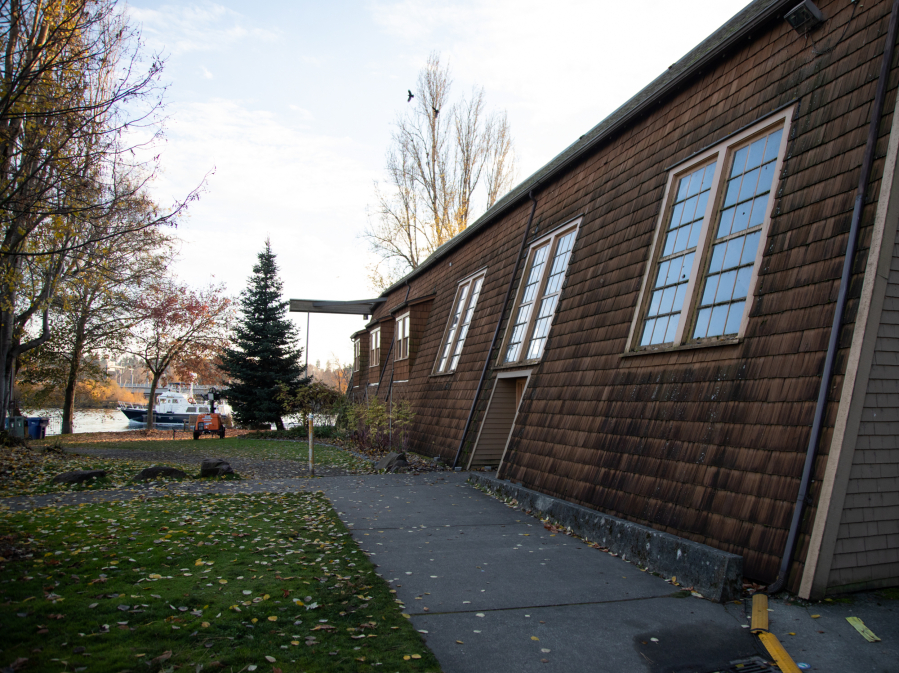Like the story of the University of Washington rowing crew that won 1936 Olympic gold, the University of Washington’s campus shell house was nearly lost to history.
The runaway bestselling 2013 book “The Boys in the Boat” brought attention to the true story of the scrappy eight-oared racing shell that inspired a country slogging through the Great Depression.
The dramatic upset victory, over crews from Hitler’s Germany and Mussolini’s Italy, was an achievement largely forgotten in the passage of time until author Daniel James Brown of Redmond revived it when he met crew member Joe Rantz’s daughter, Judy Rantz Willman. A movie based on the book is in theaters now.
At the center of it all was the 12,000-square-foot shell house that launched hundreds of crews from 1920 to 1949, and still stands on the University of Washington campus, dwarfed by 70,000-seat Husky Stadium and outsourced decades ago by Conibear Shellhouse, used by current UW rowers since 1949.
Just feet from the Lake Washington shoreline, the old shell house’s exterior looks remarkably unchanged from historic photos, when crews from nearly a century ago stood outside the massive sliding doors under ASUW Shell House lettering. (The building was run by the Associated Students at the University of Washington.)
Built at the end of World War I as a Navy seaplane hangar, and after its glory years, the shell house was used for rental canoes, an apartment and UW women’s crew team headquarters, among other things, before falling into disrepair and nearly being torn down. Preservationists saved the “Canoe House” with National Register of Historic Places designation in 1975 (due to its Navy hangar heritage, not 1936 Olympic gold), but it fell into obscurity for more than three more decades, its dignified past all but forgotten when the building was repurposed as a storage shed for boats.
‘The book saved it’
Then came “The Boys in the Boat,” and after more than two years on the New York Times bestseller list, the shell house was reborn.
“This book saved it,” said Nicole Klein, capital campaign manager of an $18.5 million effort to renovate and restore the old shell house. “Because without it, it would have just sort of fallen down on its own. It’s significant, but people just forget, right?”
Inside the structure today is a jumble of what was, is and hoped to be — vintage racing shells carved from native wood, round tables with white tablecloths from a recently held public event, exhibits and interpretive placards for the museum to come.
The “ASUW Shell House, The Next 100 Years” project announced on Dec. 22 that it met the fundraising goal, according to Klein. Contributions are still being accepted at asuwshellhouse.uw.edu.
Plans for the space include interactive exhibits, waterfront event space for students and community, a place for teaching and celebrating canoe culture and a landscape design to honor the native Duwamish, who, before the existence of Montlake Cut, used the land to carry canoes between Lake Washington and Lake Union.
A working boat-building shop will be revived in the second-floor loft, where world-famous designer, builder and rowing philosophizer George Pocock carved the 1936 Olympic champion boat, the Husky Clipper, and many others, including the 1948 Olympic gold-medal four-oared shell, from native Western red cedar. At one point, 80 percent of all collegiate boats used Pocock racing shells. Recruited by “father of UW rowing” Hiram Conibear to build boats for UW, Pocock also served as a mentor and adviser to the crew.
It’s a far cry from when people from the U.S. and abroad would poke their heads into UW rowing offices and ask coaches for tours of the shell house, where long-ago coach Al Ulbrickson had formed a team for the ages.
The school now offers more formal “Boys in the Boat” tours. The Museum of History and Industry in downtown Seattle is running an exhibit to tell Seattle’s history of rowing, as well as to honor the story of the 1936 crew. The exhibit runs until June and features Anacortes’ Hume’s gold medal.
The shell house’s resurrection is evidence of the story’s broad reach, drawing attention from people not affiliated with the university or rowing. Klein said the capital campaign received a big gift from Microsoft President Brad Smith and his spouse, Kathy.
“They’re not Huskies and are not rowers,” Klein said. “They’re not even from Seattle. They just really loved the book and the building and what it stands for — as this place where you remember the past, and that it can inspire you to get through hard things. Because that building has sure endured.”
The full-length movie, based on the book and directed by George Clooney, opened nationally last week.



